150 years of technology and engineering innovations that have transformed events
Published: Thu 7 Jan 2021
Published: Thu 7 Jan 2021
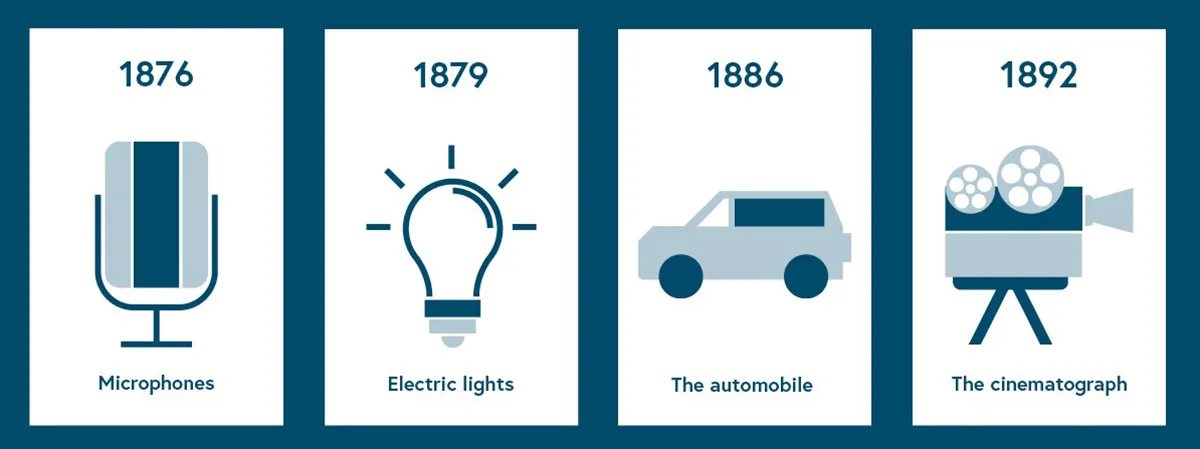
A microphone converts mechanical energy waves or sounds into electrical energy waves.
The first microphone was invented as a telephone transmitter by Alexander Graham Bell.
German physicist Johann Philipp Reis designed a sound transmitter before Bell in about 1861, but it was not effective at transmitting intelligible speech.
Bell first transmitted the human voice in 1876, and microphones have developed to become a huge part of events, used in various guises in telephones, public address systems, radios and transmitters.
Thomas Edison founded the Edison Electric Light Co in New York City in 1878.
After many experiments, he invented an incandescent lamp (commonly known as the light bulb) that could be used for about 40 hours without burning out.
By 1880 his bulbs could be used for 1,200 hours and changed the way worldwide events could be lit inside.
The year 1886 is regarded as the birth year of the modern car when German inventor Karl Benz patented his Benz Patent-Motorwagen.
Cars became popular for the masses in the early 20th century, enabling people to travel and relocate more easily both for leisure and business.
Transportation of goods also became quicker, easier and cheaper, and this opened up a new world of ingredients and supplies used in catering and events.
The Cinématographe was the first motion-picture apparatus, used as both a camera and a projector.
It was invented by Louis and Auguste Lumière, based in part on Thomas Edison’s kinetoscope.
Its invention allowed moving pictures on the big screen, and the technology behind it is still used today for the presentation of films to large crowds.
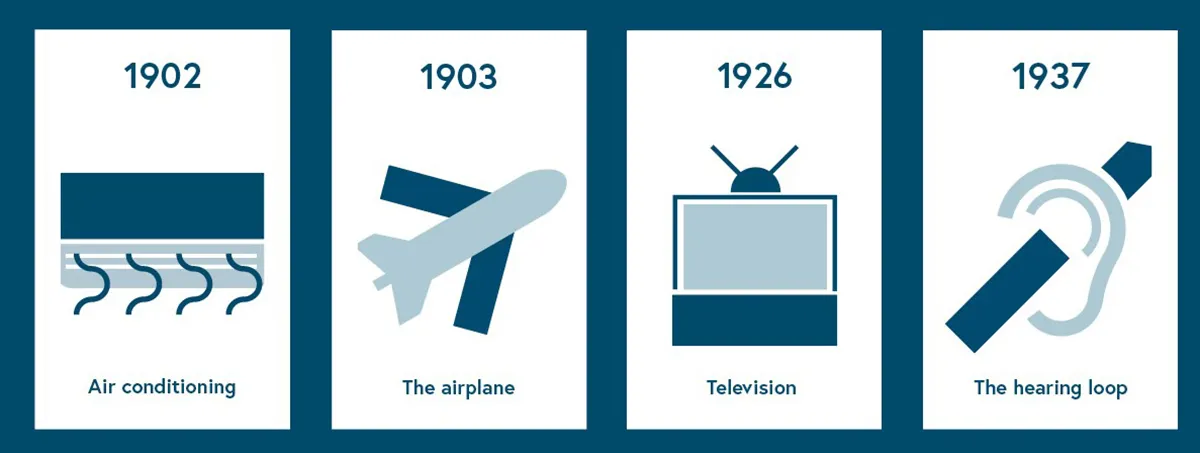
Air conditioning is the process of removing heat and moisture from the interior of an occupied space to improve the comfort of the occupants.
The first modern air conditioner was invented in 1902 by Willis Haviland Carrier, a skilled engineer who began experimenting with the laws of humidity control.
This launched an industry that would fundamentally improve the way we live and work, allowing large crowds of people to congregate in comfort.
Wilbur and Orville Wright were American inventors and pioneers of aviation who achieved the first powered, sustained and controlled aeroplane flight in 1903.
This was surpassed two years later when they built and flew the first fully practical aeroplane. The impact on the aeroplane on the 20th century is beyond measure.
An entirely new world was created, allowing people to travel across the world with ease for leisure and business.
Television is a way of sending and receiving moving images and sounds over wires or through the air by electrical impulses.
In 1926, John Logie Baird, a Scottish inventor, electrical engineer and innovator, demonstrated the first working television system in London.
This was an amazing breakthrough in technology, paving the way for a new and exciting industry that is still flourishing today.
The hearing loop was invented by Joseph Koliakoff in 1937.
It is a special type of sound system for use by people with hearing aids, providing a magnetic, wireless signal that is picked up by the hearing aid when it is set to 'T' (Telecoil) setting.
Its invention transformed the accessibility of events for those with hearing impairments and is now a requirement for all venues as part of the Equality Act.
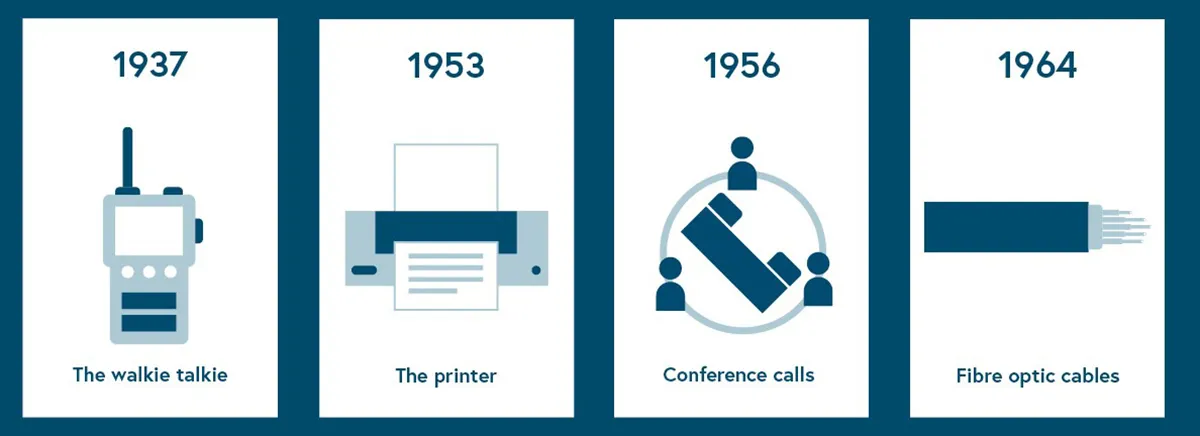
A walkie-talkie, more formally known as a hand-held transceiver, is a hand-held, portable, two-way radio transceiver.
Before the mobile phone, it changed the dynamic of communication into something where you could talk to someone a long distance away while still having the flexibility of mobility.
The first device to be widely nicknamed a "walkie-talkie" was developed by the US military during World War II and is still used by on-site organisers of large-scale events.
The first mechanical printer was designed in the 1800s, but it was not until 1953 that Remington Rand developed the first high-speed printer to be used with the UNIVAC computer.
Although typewriters were still primarily used at this time, it saw a new era of ease for businesses everywhere.
Conference calling was invented by Bell Labs in 1956 and introduced to the public by AT&T at the 1964 New York World's Fair.
Called the Picturephone, this invention invited the visitors to talk to persons thousands of miles away at Disneyland in Anaheim, California.
The internet didn’t exist yet and the computers used were as big as rooms, but it started the process we now rely on every day to communicate with larger groups.
Fibre optics is the contained transmission of light through long fibre rods of either glass or plastics.
Since the 1930s thin filaments, or fibres, of glass have been used to see inside the body, but these long remained unusable for long-distance information transfer because too much light was lost along the way.
In the 1960s Charles Kao presented a solution: fibres of very pure glass transported sufficient light. Together with laser technology, his solution has made telecommunication using optical fibres possible.
Fibre optic cables are used for transmitting voice, images, and other data at close to the speed of light.
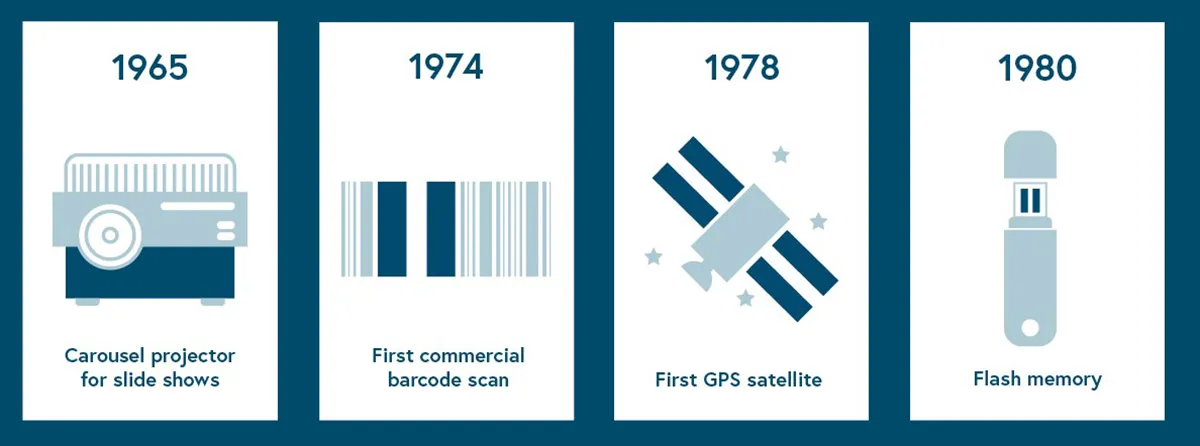
A carousel slide projector is a projector that uses a rotary tray to store slides, used to project slide photographs and to create slideshows.
It was first patented in 1965, by David E. Hansen, an industrial designer at the Eastman Kodak Company.
It was a game-changer in its time, as it allowed presenters to project bigger images on to screens for easier viewing with less eye strain.
A barcode is an optical machine-readable representation of data relating to the object to which it is attached.
Barcodes are used by companies, large and small, to more efficiently and accurately identify, track and inventory products, assets, supplies and even attendees at events.
The first-ever item scanned by a UPC barcode was a pack of Wrigley’s Juicy Fruit Gum at a supermarket in Ohio in 1974.
The Global Positioning System (GPS) is a satellite-based navigation system made up of at least 24 satellites.
The satellites were originally put into orbit for military use, but they were made available for civilian use in the 1980s.
GPS works in any weather conditions, 24 hours a day. GPS is now widely used in mobile phones and receivers that can calculate information such as location, speed and distance to destination, making accurate travel to events a lot easier.
Flash memory is a solid-state chip that maintains stored data without any external power source.
It is commonly used in portable electronics and removable storage devices, and to replace computer hard drives.
Another game-changer for those working remotely or on the move, it was invented by Fujio Masuoka in the early 1980s for Mitsubishi.
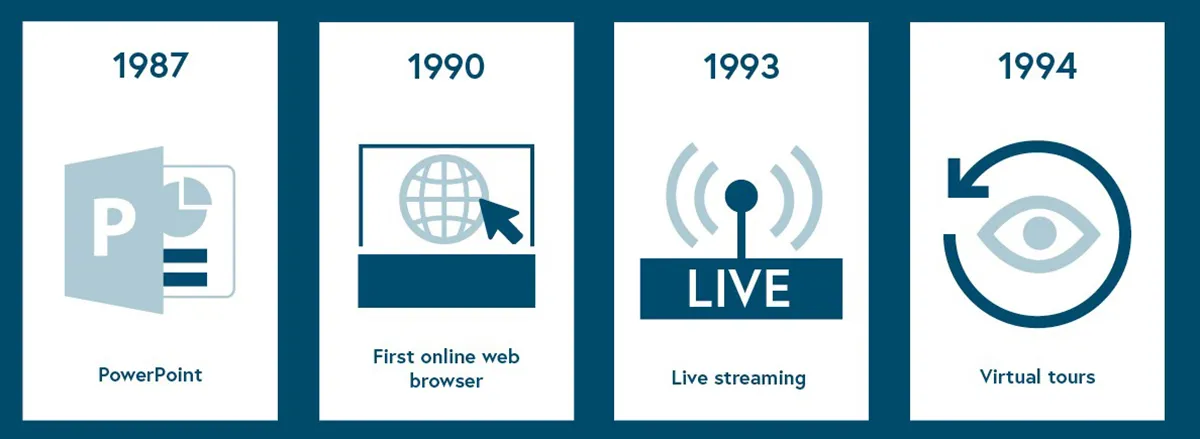
On April 20, 1987, PowerPoint 1.0 for Macintosh was released by a company called Forethought.
It was a presentation software never seen before, originally designed to provide visuals for group presentations within business organisations.
Microsoft acquired PowerPoint in July 1987 as their first large acquisition and made the software available for a wider group of users.
PowerPoint is still one of the most used applications by both business and private users wanting to create impactful presentations.
A web browser is a software application for accessing the information on the World Wide Web.
The first web browser, called WorldWideWeb, was created in 1990 by Sir Tim Berners-Lee and was the only way to access the internet at this time.
It opened up a new world of possibilities and access to data and information.
Live streaming is now one of the most popular forms of broadcasting, but the first-ever live streaming of an event on the internet wasn’t quite planned – a group of engineers at an event in Palo Alto, CA decided to broadcast a jam session by the band Severe Tire Damage, to test out some new technology.
The session was watched by people as far away as Australia and started a new trend that has only become more popular since the introduction of social media.
The first example of a virtual tour was a museum visitor tour consisting of a 'walk-through' of a 3D reconstruction of Dudley Castle in England as it was in 1550.
Virtual tours are designed to allow customers and clients to step inside a business from any device, visually engaging them and giving a better idea of what a company is offering without a physical site visit.
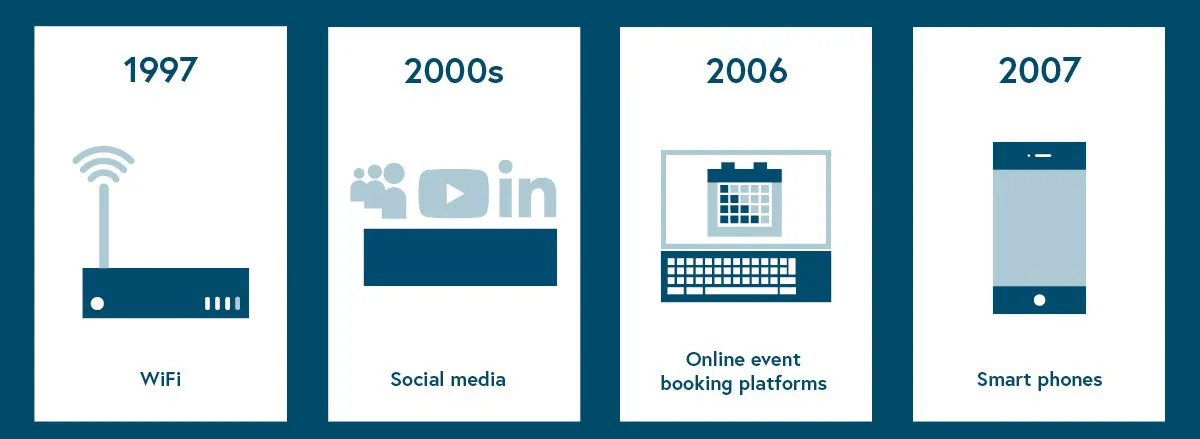
WiFi is short for Wireless Fidelity. WiFi is a wireless networking technology that allows devices to communicate over a wireless signal, with a router attached to the internet via an ethernet cable.
Vic Hayes has been called the "father of Wi-Fi" because he chaired the IEEE committee that created the 802.11 standards that would make WiFi feasible in 1997.
WiFi is now widely adopted around the world and often essential in events, aiding networking, streaming of content and sharing data.
After the invention of blogging, social media began to explode in popularity in the 2000s.
MySpace, LinkedIn and YouTube were forerunners, closely followed by sites like Facebook and Twitter, creating new ways for people and businesses to connect and communicate with each other.
For many events, such as award ceremonies, social media channels often act as a live stream of regular real-time updates.
In ‘the old days’ people used to line up at the box office to get tickets for events.
However, in the early 2000s, ticketing and event booking moved online with the founding of specific transaction hubs such as cVent and EventBrite.
These types of systems have revolutionised event sales as they allow anyone with a computer and internet connection to sell – or buy – tickets or places at events online.
The first true smartphone actually made its debut in 1992.
It was called the Simon Personal Communicator, and it was created by IBM.
However, 2007 was the most influential year for the smartphone evolution, when Steve Jobs and the team at Apple revealed the first iPhone.
The sleek, touchscreen device was the first to of

Although tablets were initially developed as far back as 1960, 2010 is seen as the year when tablets achieved widespread popularity with the release of the Apple iPad.
Apple sold more than 15 million first-generation iPads before the second generation was released.
The new technology had an enormous impact on both business and private use, allowing users access to their databases in an easy-to-use handheld device without cables.
Event applications started as a new innovation to replace the printed guide for attendees, offering innovative and sustainable ways to elevate the attendee experience and help organisers optimise their event.
Integrated event apps have become a hub of interactivity that includes audience participation, attendee networking, session surveys and even location-based messaging and way-finding and have made the move from physical events to successful hybrid and virtual events possible.
According to some, the father of facial recognition was Woodrow Wilson Bledsoe.
In the 1960s, he developed a system that could classify photos of faces using what's known as a RAND tablet.
Today, facial recognition technology has risen in popularity, making it commonplace and easily accessible.
Apple’s Face ID was introduced in 2017 as a privacy feature on their iPhones to ensure the user is the only person who can access the internal contents of their device.
This software is now starting to be widely used at events to ensure delegate safety and accurate admittance of guestlist attendees.
Although artificial intelligence has been in the making for many years, 2018 marked the development of ground-breaking technologies which has led to more than one billion voice-enabled digital assistant devices worldwide.
Chatbots are being used to field FAQs without the need for a manned support line and automated responses are reaching delegates.
In some cases, AI has reached heights of being able to read the room, assess attendees’ food preferences, movements, and provide valuable insights and trends for future events.